#lner a4
Text

LNER A4 Gang
From left to right: Dominion of New Zealand, Dwight D Eisenhower, Empire of India, Golden Eagle, ???
26 notes
·
View notes
Note

What are they doing?
They're express engines. They're discussing the state of the railway (gossiping)
but fun thing, there are only 4 A4s here
far right isn't an A4, it's Hush Hush

yep, the LNER's rebuilt white elephant. By all acounts I've found, post rebuild she was just a non-standard A4. Although it is worth noting Gresley was considing rebuild the A4s with the boiler fit to no.10000, so he was impressed with that at part of the rebuild at least.
heading left, we have Golden Eagle
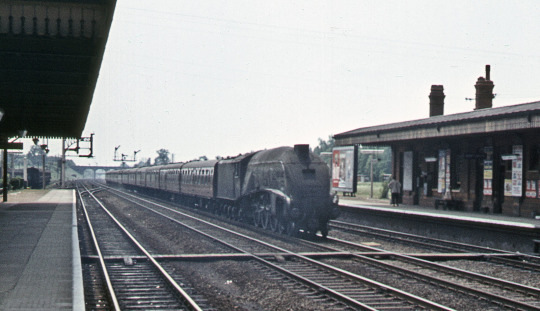
Empire of India (my beloved)

Golden Shuttle, who was later renamed Dwight D. Eisenhower and Preserved
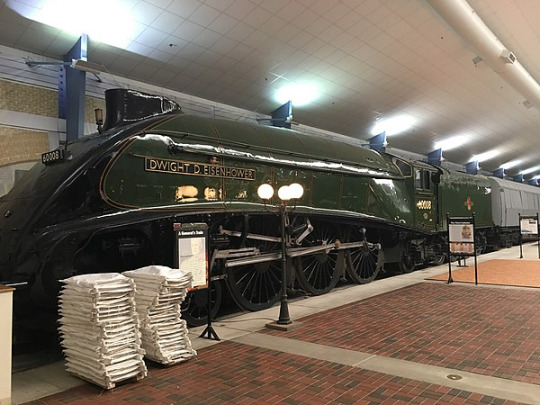
and Dominion of New Zealand

#Hazel Asks#Ask Hazel#Hazel Q&A#LNER#London North Eastern Railway#LNER A4#LNER W1#4-6-2#4-6-4#A4 Pacific
32 notes
·
View notes
Text

Two A4s in their human form
I present to you two more members of the big Gresley family. Spencer and Sir Nigel Gresely. I mentioned them a lot (especially SNG) but never drew them. Here are some fun facts:
Spencer often dines with the Boxfords if possible. Mrs. Boxford occasionally hands him a box of pralines which he eats in his shed alone. Also he and Henry got in a fist fight and Henry whooped his butt.
Sir Nigel Gresley despite his very stern demeanor is absolutely terrified of Madame Eugénie. And he is a very by the book guy. So even the slightest breaking of rules in his presence results in him scolding you. Making him the biggest party pooper. He snitched on Scotsman because he heard Scotsman and Ms. Addams in her office talking very suspiciously.
#ttte#thomas and friends#ttte humanized#ttte human au#ttte gijinka#ttte spencer#sir nigel gresley#lner a4#gresley family#thomas and friends humanized#spencer the silver engine#Two more Gresley bozos#they are somewhat antagonistic but still very fun#SNG is a bit of a snitch#Mrs. Boxford absolutely spoils Spencer.#Yes they are brothers XD#humanized locomotive
35 notes
·
View notes
Text
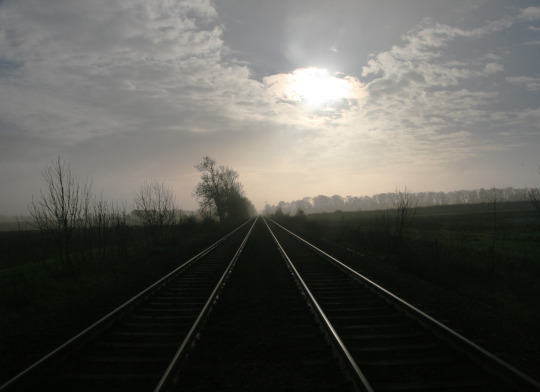


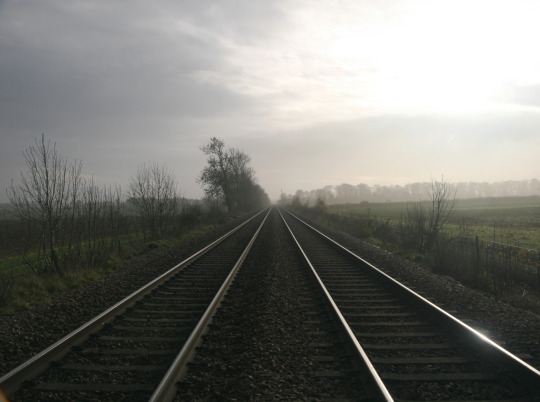
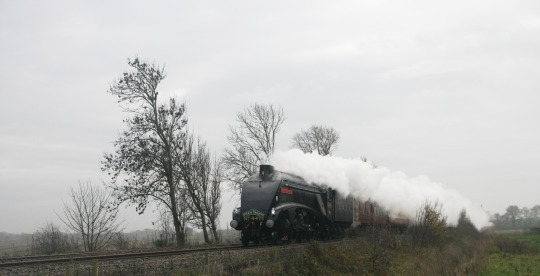
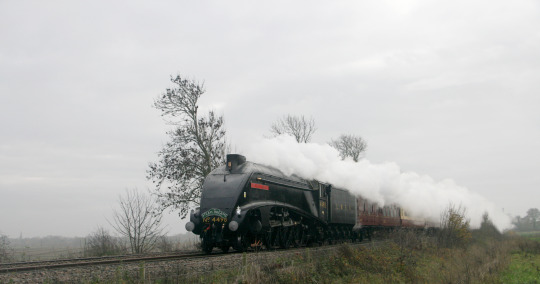

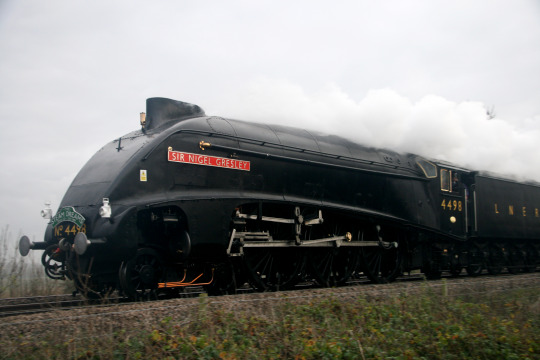

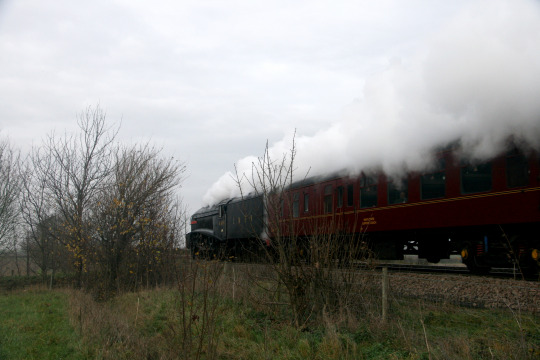
Sir Nigel Gresley comes to Lincoln, December 2022
#steam locomotive#photography#england#british railways#steam engine#LNER#Sir Nigel Gresley#NE#LNER A4#A4#Steam train#winter#locomotive
42 notes
·
View notes
Text
Happy Mallard Day!
Most people in my country will be celebrating tomorrow, July 4th. I’m a bit unusual for an American in that I’m always more excited for July 3rd, because a remarkable feat of engineering history happened that day in 1938 (in multiple senses of the word). Today I’m going to tell the story of a locomotive named for a duck.
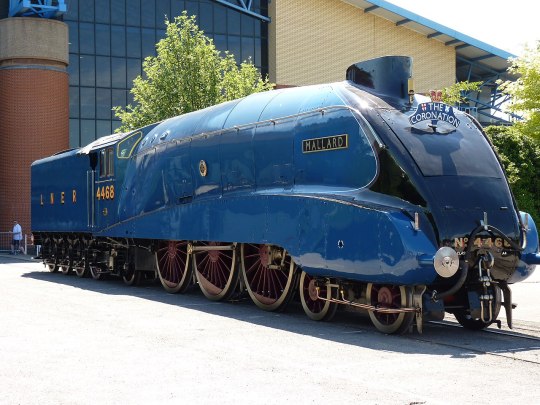
(Image: 4468 Mallard, a streamlined 4-6-2 Pacific locomotive, sitting pretty in York, England, United Kingdom. She is painted bright blue with red wheel spokes.)
The story begins well before July 3rd, 1938, of course - mechanical engineer Sir Nigel Gresley was well established in his position as the CME of the London and North Eastern Railway by that date. In 1923, his most famous creation, a 4-6-2 Pacific A1 numbered 4472, took to the rails for the first time. Originally numbered 1472, within a year of running between London to Edinburgh she received her more familiar 4472 after the LNER finally settled on a company-wide numbering scheme - and the name she’d be best known under, Flying Scotsman. She became the company’s flagship locomotive and solidified Gresley’s ability to design Pacifics in the mind of the public.
Her most important contribution to what I’m about to get into the meat of here, though, occurred on November 30th, 1934. On that date, pulling a light testing train behind her, Flying Scotsman hit 100 mph, becoming the first locomotive to hit that speed whilst being officially measured. Other locomotives may have reached 100 mph before, most notably GWR 3700 City of Truro and NYC 999, but this was the first time the speed was officially recorded, and so Scotsman got her name into the record books.
Dating back to the 19th century, railroads in Great Britain competed against each other in what was known as the Race to the North, in which they actively attempted to outdo each other and get passengers from the south, usually London, up to various destinations in Scotland. Nobody ever actually said they were racing, of course, but in retrospect it was pretty obvious what was going on as the railroads introduced faster and faster services. By the 1930s, the railroads had been consolidated into four companies - the Big Four (the Great Western, the Southern, the London, Midland and Scottish, and the heroes of this story, the London and North Eastern). The LMS controlled the West Coast Main Line, and the LNER controlled the East Coast Main Line. (This is important.) In 1927, the LNER started running the named train Flying Scotsman non-stop from London to Edinburgh, utilizing corridor tenders to perform crew changes at speed without stopping. Not to be outdone, the LMS beat them to the punch, running non-stop services between London and Glasgow and London and Edinburgh on their own, and it was officially on. Although speeds were still within a reasonable range at this point, both railroads knew they needed to go faster, and Sir Nigel Gresley looked to Germany.
In Germany, a new streamlined service called the Flying Hamburger had been introduced. This was a diesel train set that ran between Hamburg and Berlin at remarkably high speeds - it had an average speed of 77 mph and could hit around 99-100 mph at its maximum. For regular service, this was impressive, and Gresley wondered if the same could be done using steam power. He knew streamlining was the key, but the LNER knew that the diesels in Germany didn’t have the same passenger capacity as their steam locomotives could pull in carriages, so he needed to get creative. He looked to Bugatti for inspiration; their racecars, in their resplendent blue, were but one thing the car company was working on - they were making streamlined railcars, as well. Gresley took note of their designs, and his new locomotives would eventually pay homage by being colored Bugatti blue.
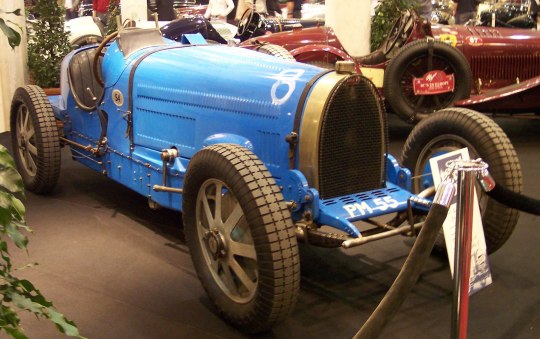
(Image: a Bugatti Type 54 racecar, painted in a vivid blue.)
By the time Flying Scotsman hit 100 mph in 1934 and another Gresley Pacific locomotive, A3 2750 Papyrus, managed to hit a whopping 108 mph without streamlining, the LNER knew that Gresley was capable of the task, and they allowed him to design a streamlined locomotive. Gresley set to work making improvements to his A3 design, and the first four A4s were born.

(Image: an unidentified A4 Pacific locomotive.)
The A4s were fast, hitting 112 mph on the inaugural run of the Silver Jubilee service between London and Newcastle in 1935. Gresley, of course, was not satisfied - he knew he could still improve his design, and at any rate, his competition over at the LMS was going to be trying to catch him. He went back to the drawing board to make the A4s even better.
As this was going on, the LMS was indeed playing catchup, and they introduced their beautiful Coronation class locomotives, designed to pull the Coronation Scot starting in 1937. The first several of them were streamlined in gorgeous, bright casings, and they caused a stir, taking the British speed record back at 114 mph in an attempt by 6220 Coronation that ended with a sudden braking and a whole lot of kitchenware being flung every which way in the dining car. Engineer/driver T.J. Clark and fireman C. Lewis kept her under control, but the passengers were not amused, and speed records were shelved for the time being...until, once again, Germany entered the fray.
Back in 1936, a German locomotive, the DRG Class 05, set a land speed record for steam, hitting 124.5 mph. Gresley was aware of this and had it in the back of his mind as he improved his A4s. He experimented with giving some of them a Kylchap exhaust system, an innovation developed by French locomotive designer André Chapelon after the work of Finnish engineer Kyösti Kylälä. Chapelon’s work went woefully under-acknowledged, but Gresley paid attention and appreciated his work, and it would pay off. Wind tunnel tests proved a bit frustrating at first until a fortuitous accidental thumbprint helped to move the smoke up and over the locomotive instead of in the crew’s faces, and the stage was set.
4468 Mallard rolled off the line at Doncaster Works on March 3rd, 1938, her name derived from Gresley’s love of breeding waterfowl. Indeed, many of her sibling locomotives were also named for birds, like 4464 Bittern, 4467 Wild Swan, 4902 Seagull, and 4903 Peregrine, but the duck was about to steal the show. Mallard spent the next few months getting used to working and being broken in so she wasn’t brand new, and on the day she turned four months old, it was time to make history.
Mallard’s driver that day was a 61-year-old grandfather named Joe Duddington. As a locomotive engineer, he was experienced and knew how to take calculated risks, and so he’d been assigned to pilot her. With him on the footplate was fireman Tommy Bray and his massive tattooed arms, ready to keep Mallard fed as they drove into the history books. They were performing a “brake test” that day, or so the LNER told most people, passengers included, but Joe and Tommy knew what was actually going on. In the cab with them was an LNER official, Inspector Jenkins, and attached to the train behind the tender was a dynamometer car, there to record Mallard’s speed throughout her run. Since this was an alleged “brake test” the dynamometer car didn’t raise any eyebrows right away. Gresley himself unfortunately wasn’t in the best health that day and was unable to be present himself, but there were enough LNER officials on hand to see to it that everything ran smoothly. Mallard was fitted with a stink bomb of sorts of aniseed in case the big end bearing for the middle of her three cylinders overheated, as the A4s had previously had difficulty with this, and she set out heading northwards. The return trip was where everything was going to get serious.
Upon turning around to return south to King’s Cross, passengers were finally informed of what was going to happen and were given the opportunity to disembark and take another train if they were worried, especially given what had happened during the LMS record attempt a year prior. Everyone agreed to stay on board. Joe Duddington turned his hat backwards, a reference to George Formby’s character in the film No Limit, and opened the throttle.
Mallard slid back onto the main line, headed towards Grantham, where the speed-up was to begin. Unfortunately, work on the track limited her to only 15 mph at this stage, and Joe Duddington got her through the Grantham station at only 24 mph instead of the 60-70 mph she should have been at. Nevertheless, she began to build up more and more speed as she climbed up Stoke Bank, and Duddington had her at a solid 85 mph at the summit.
“Once over the top, I gave Mallard her head, and she just jumped to it like a live thing,” Duddington recounted later in an interview. Her speed rapidly increased, and she was soon hitting 110 mph, at which point he told her, “Go on, old girl, we can do better than this!” Mallard responded, and by the time she was flying through a village called Little Bytham, a blur of blue paint and pumping rods and flying ash, she had well exceeded the LMS record and was even with the German DRG Class 05. The needle in the dynamometer car tipped up higher and higher and surpassed the Class 05 by slipping up to 125 mph...then, for about a quarter of a mile, reached even higher, at 126 mph. She’d done it.
Mallard had to slow down soon after because of a junction, but Joe Duddington and Tommy Bray were sure she could have gone faster had they not had to slow for construction - they believed she was capable of 130. The big end bearing did overheat, and Mallard was detached from the train at Peterborough and brought back to Doncaster to be fixed up, but not before one of the most famous photos in railroad history was taken:
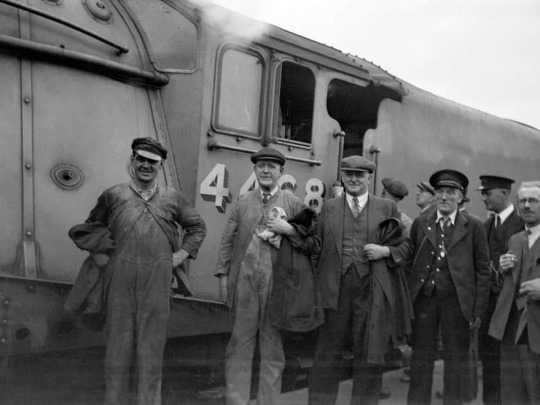
(Image: the crew poses in front of Mallard, a 4-6-2 Pacific locomotive numbered 4468, immediately after setting the speed record. L-R: Tommy Bray [fireman], Joe Duddington [driver/engineer], Inspector Jenkins, Henry Croucher [guard/conductor]. Joe Duddington has turned his hat around to face the correct way again after having it on backwards during the record run. Photo credit: National Railway Museum.)
Joe Duddington actually stayed on a bit past his retirement age to help free up soldiers for the war effort. When he finally retired, on his final day of work, he drove Mallard one last time.
Sir Nigel Gresley himself never accepted the brief stint at 126 mph, instead saying his locomotive set the speed record at 125 mph. But history has accepted the 126 mph as the true top speed, given that Mallard was possibly capable of even more, and today she has plaques on her streamlined cladding to commemorate her feat. A second record attempt was planned to see if she could go even faster, but World War II broke out and the idea was scrapped.
undefined
youtube
Tommy Bray eventually got on the throttle himself, fulfilling his own dreams. Both men are honored in a cemetery in Doncaster with a new memorial headstone for Duddington featuring Mallard on it.
As for Mallard herself, she continued working until April 25th, 1963, at which point she’d clocked nearly a million and a half miles in service. She was pulled for preservation for obvious reasons, and today she lives at the National Railway Museum in York, along with her dynamometer car that recorded her history-setting run. Five of her A4 siblings also survive, and a few of them are operational to this day, including the one named for her designer, Sir Nigel Gresley. Of all of his ‘birds,’ the one that flew fastest was the humble duck.
For more on Mallard and her creator Gresley, here are a few resources:
Mallard: How the Blue Streak Broke the World Speed Record by Don Hale is a great book on the subject that I enjoyed thoroughly. It does have a Kindle edition if you’d prefer an ebook variation, as well, and most major book retailers carry it on their websites.
The National Railway Museum, Mallard’s retirement home, has a 3D experience/ride of sorts that simulates what it was like to be running with her that day, the video of which is online here. Note the music, which mirrors her three cylinders pumping away. The video isn’t able to be embedded, but you can watch it here. There’s also a child-friendly version, too.
Lastly, the appropriately named prog rock band Big Big Train did a song about Mallard called East Coast Racer, which regularly moves me to tears because this locomotive means so much to me and they tell her story so lovingly.
undefined
youtube
I actually recommend checking out the live version, too, because they show the photo of the crew at the end and every single time I start sobbing.
If you want to visit the old girl herself, she’s at the National Railway Museum in York in the UK, and they have a ton of amazing resources and incredible locomotives and rolling stock in their collection. I’d highly recommend checking them out if you can!
Happy Mallard Day, everyone. Fly far, fly fast, make history.
#LNER Mallard#LNER 4468 Mallard#LNER#LNER A4#I like trains#I spent literal hours on this whoops#but she's really important to me
50 notes
·
View notes
Text

Insert obligatory "haha not dead" text blurb here
Anyway Spencer was one of those characters I put off drawing for the longest time since I always thought drawing his streamlined casing would be a pain in the ass but surprisingly he was kinda fun to draw
#ttte#thomas and friends#thomas the tank engine#rws#railway series#locomotive#ttte spencer#spencer#lner a4#traditional art#spencer the silver engine
25 notes
·
View notes
Text
[STICK3RS]

Hans disapproves of TUN3R's Choice of very...Interesting Stickers
Welp, Yeah those stickers are definitely a tease, I personally thought they were a little too cheesy, but when I textured Tuner's engine, a few friends and me were sitting in a discord call, and we decided to just add them, they are all in german to kinda capsulate the fact he is an east german replica A4, that is out for a lil stress, I think they add to the character as a small detail.
yes, he still has the number 6969 after 2 years, because this man just can.
ENG BELOW

12 notes
·
View notes
Text
The Fallen King
The Flying Scotsman rolls into the station at the end of a busy day.
Scott: Ahhh. Another successful non-stop run. The A3s will run this railway for years to come.
His driver, William winces.
William: I wouldn't say that, Scott. I've heard some rumors that Sir Nigel Gresley is set to put his latest design, the A4 into service next month.
Scott uncharacteristically splutters and turns red with annoyance.
Scott: This is preposterous! Have I not proven my worth to Sir Nigel Gresley? I can't just be replaced as if I haven't been operating this incredible service to the railway for over 10 years.
William: Shhh. Steady old boy. Just because the design is meant to provide high speed passenger rides, doesn't mean you will be replaced.
Scott: I sure hope so, William.
Time Skip
One day in 1938, Sir Nigel Gresley appeared at the sheds.
Nigel: Good morning, Scotsman.
Scott: Good morning, Sir.
Nigel: I know you've been feeling down about being replaced, but I bring good news. You are being seen as a role model by the A4s. In fact, I want you to take me to the Doncaster Works. There's an engine I want you to meet.
Scott sighs. He knows he shouldn't be so jealous, but he thought he would have his record at least a little longer.
Scott: Yes sir.
The Flying Scotsman takes Sir Nigel Gresley to the Doncaster Works. An engine freshly painted painted garter blue sits on the rails faceless.
Nigel: Now in just a minute, my latest modification of the A4 will wake up. I believe if this works, this engine will once again be a credit to the railway. In fact, as you have been the only engine in recent British history to do so, I want you to mentor this engine. Streamlining by design will make an engine fast, but it takes great skill to manage such high speeds.
Scott: Oh. Well it's an honor, sir.
Scott means what he says, but it's still bittersweet. To him it hurts to have to be responsible for training his own replacement. Being demoted from the Flying Scotsman services was quite a blow.
?: Hello?
Nigel: Ah yes. Welcome to the world young engine. I am your designer, Sir Nigel Gresley. Due to my fondness of birds, I decided to name you Mallard.
Mallard: Mallard, sir?
Nigel: Indeed. The Mallard is one of the most famous birds in the world. Due to the modification I added starting with your design, I highly believe you will become one of the most famous engines.
Mallard: My goodness. Thank you sir!
Sir Nigel Gresley chuckles. He walks over to the Flying Scotsman.
Nigel: This is one of my most famous engines, the Flying Scotsman, known for being the first official engine to reach 100 mph. He will act as your mentor regarding how to handle high speeds. We value fast, safe, and reliable service on this railway. Is that clear?
Mallard: Oh yes sir! Thank you for giving me a mentor.
Nigel: Well I'll just leave you two alone then. There's a lot of work to be done.
Scott sighs. It's not at all Mallard's fault that he feels this way. Given the circumstances, the least he can do is make Mallard as reliable as himself.
Time Skip
Mallard: Scotsman, why am I being asked to pull a train like this just to test my brake?
Scott: This is meant to simulate pulling a real train. The men added a dynamometer car to measure your speed and other elements of your performance.
Mallard: So it was just like my tests before I pulled my first passenger train.
Scott: Indeed. Only this time, the hope is that you will be fit to break the speed record. Should the bearing on your middle cylinder overheat even with the modifications, it would mean more work is to be done. We don't want you hurting yourself just to break a speed record.
Mallard contemplates this. He doesn't want to let anyone down. Especially if it's because of something he can't control.
Mallard: I understand.
Jospeh: Alright, Mallard. It's time to start our journey.
Mallard: Very well then, driver.
Mallard rolls out into the distance. Something about the day makes Scott only dread his worse fear is about to become a reality.
Time Skip
Crowd: He's done! Mallard broke the speed record!
Scott solemnly closed his eyes. Even though he isn't old by any means, this news made him feel as if he's aged.
Gordon: Why the long face, brother?
Scott: I feel as if my time to shine's ended before it truly ever began.
Gordon: Oh don't tell me that you're jealous of Mallard.
Scott looks at Gordon. He shakes his head knowing jealous isn't at all the correct term.
Scott: This is not at all Mallard's fault. He's simply doing what he's told like any young engine would. It isn't as if I didn't know my speed record would be broken one day.
Gordon: So why are you upset?
Scott: I wish I was able to have that to my name a while longer. To be allowed the chance to live out my prime as the best of the best. I would be willing to accept being replaced should it be well over 50 years of service and I'm no longer reliable. But to be replaced this soon.... I just didn't expect it.
Gordon: At the end of the day this is a business. What's best for the business is to ensure our passengers have fast, safe, and reliable rides. By mentoring Mallard, you are ensuring that guarantee. That is being a really useful engine. Like I said before, get some perspective Scott.
Scott shuts his eyes sighing again. If only there was a way to explain that Gordon is right but he should still be allowed to his feelings.
Scott: I only hope that Mallard doesn't meet the same fate as me. Falling from grace for things that is not at all your fault is something I wouldn't wish on anyone. No one should ever have to worry about facing the cutter's torch.
Gordon: Indeed, Scott. Indeed.
AN: Thank you anon for requesting this. I didn't realize that the real life A4s did in fact replace the Flying Scotsman until I started learning about the history a little bit more.
Tagging: @nelllia, @gordon208, @jayde-jots, @mintydeluxes-blog, and @engineer-gunzelpunk.
8 notes
·
View notes
Text

(if you get it you get it) 🦆
#Sir Nigel Gresley and his beloved Mallards#A4#LNER#LNER A4#locomotive#Mallard#Gresley#Sir Nigel Gresley#London North Eastern Railway#LNER A4 Pacifics#Sir Herbert Nigel Gresley#streaks#125.88 mph#Dwight D Eisenhower#Union of South Africa#Dominion Of Canada#Bittern#4468#4464#4489#4488#4496#4498#is it too late to make the aspect ratio the same as an A4???? someone#🦆
33 notes
·
View notes
Text

[Until the end of time]
Once one in a class of 35, Kingfisher worked a fairly normal life - for a Gresley A4.
When Modernization hit, he clung to what he had. And if he had to make… sacrifices, then so be it.
But as they always do, he got more than he bargained for. Nowadays, engines at their end talk of a big ultramarine engine with faded, cracking paintwork and rust forming in nearly every section where sheet metal connected, coming to take them away.
What must have been an attempt to ease the fear and pain upon passing, had since turned into a premonition. A warning when an engine passes the point of no return, to cart them off to God knows where one last time.
He grew to abhor the job after that. But no matter where he went, no matter how fast he ran, there was always work to be done.
He had a job to do. He still has a job to do.
#kingfisher#ttte#thomas the tank engine and friends#lner a3#lner a4#british railways#so i saw this one photo of an A4 and some A3s once
8 notes
·
View notes
Text
I have an interesting headcanon about some A4s (Dominion of Canada, Union of South Africa, and Dwight D. Eisenhower)
Since they lived abroad for a long time (Union didn't irl, but whatevs), they have a blend of two different accents
#ttte headcanon#ttte union of south africa#ttte dominion of canada#ttte dwight d eisenhower#ttte au#headcanon#lner a4
3 notes
·
View notes
Text

Redraw of an old piece I did back in 2017 featuring one of my oldest locomotive characters. Silver Lady The LNER A4.
Golden Plover: "Sis garter blue is not that bad of a colour really, I think it looks very beautiful on all of us."
Silver Lady: "Well I don't! Must we all be wearing this disgusting common blue we've all been forced to wear as standard, instead of keep some of our class such as myself in the liveries we originally came out in when we were finished being built! I look hideous!"
Golden Plover: "It's up tops orders I'm afraid Silver Lady and we can't do anything about it. Besides the Silver and Apple Green liveries were very difficult for the cleaners to keep clean and shining, and you know we A4's are express engines, so we must always keep up appearances before our daily express runs. As our CME usually say's to us cleanliness comes before usefulness, and you look fine in your new livery."
Silver Lady: *Scoffs* "No Golden Plover I do not! I look like the rest of your batch, and doesn't make me stand out from any of you! It doesn't match with the colour of my coaches who are apart of the train I haul, and it's name happens to be the 'Silver Jubilee' meaning that it's meant to be an all Silver coloured consist throughout complete with engine to match! So, I'm supposed to be this beautiful, good looking, shiny Silver streamlined engine who pulls a consist of streamlined coaches with a matching livery, and the right one too! I' am not good looking right now! As my livery doesn't match my consist, making the point of it's namesake pointless, as I look like a blue whale who's pulling a mismatched train with the wrong colour, and to add to that my make up doesn't match up as well! So, honestly the passengers will think I look terrible, because I do look like it!"
Golden Plover: "Sister, I know you really liked your Silver livery as it always made you feel good about your appearance. But having a matching livery just to match a consist of coaches of a named train which has a name associated with that colour, doesn't really matter at the end of the day. As the passenger's won't mind what colour their engine in front is in, as long as they have the right engine to pull their train, and it arrives at it's destination on time. So, I suggest you get over it sis and just live with wearing the wrong colour for your coaches."
Silver Lady: "Easy for you to say Plover! But I don't accept being in this livery that easily, and oh look my express is ready. So, I can't waste time complaining about how awful this livery is, and how much I hate wearing it all day. So good day Plover, and I'll see you later this evening when I'll continue complaining about this disgusting blue to you and the others." *Steams off for the station with grumpiness boiling inside her.*
Golden Plover: "She'll learn eventually."
Silver Lady as everyone knows, has always been identified as a Silver Streak in preservation due to her wearing her iconic LNER Silver livery, which is her most preferred colour to wear as it represents her time pulling the Silver Jubilee streamlined express service between London and Newcastle during the late thirties, and was the first livery she wore after rolling out of the works in 1936.
However, despite Silver being the livery she is identified in, Silver Lady has worn many different liveries throughout her service life like most of her siblings. From wartime black to BR Brunswick Green with her having varying opinions on each one she wore. Her latest favourite livery and the one she's always had a huge distaste of wearing, happens to be LNER Garter Blue livery. She never liked being painted in that livery as to her it looked ugly and hideous, and happened to become the standard livery for her class, that she was forced into wearing due to the cleaners seeing it as a much easier livery to clean than the Silver livery she adored so much. Fueling her dislike for the livery as she saw it as lackluster, didn't match with her name and the name of the express service she usually pulled and had become so common among her class that it seemed forced for them to wear only one paint colour.
Silver Lady also thought the livery ruined her trains image, as she used to believe that everything had to match with the livery of the coaches she usually pulled behind her, and the passengers would find it appealing that there was a mismatched painted A4 pulling the train up in front that seemed out of place and didn't match the coaches, to the point where she thought they would laugh at her for looking odd among the rake of silver coaches. This idea give her constant anxiety to where one day, while an LMS 4F was complementing her livery while saying how it didn't match her coaches while waiting at Peterborough, she angrily left her train on a siding, and run away down the LMS's line to Birmingham. Arriving at Leicester where she run into who would become her first mate, LMS Princess Coronation Class No. 6220 Coronation, who had been taking time off to casually explore the line and to use it to sneak onto LNER metals for an adventure.
When Silver Lady told him what she was going through with her new livery, Coronation helped her learn that it didn't matter how she looked for her trains and that no one will judge her for looking different than what she would usually prefer to look, as it was the inside of her hiding underneath that livery that brought out her true beauty of herself and her class at the end of the day regardless of what livery she wore. This helped Silver Lady to appreciate the engine she truly was on the inside, and to accept that she won't always be in the livery she preferred to be in, and she would have wear any livery regardless of what she thought of it, even if it was one she very much disliked like the Garter Blue livery she was wearing. In the end although she still disliked blue, it didn't bother her that much anymore if she had to wear it, even when she was painted into it again after the war for a short period.
When Silver Lady was preserved by the North Ousingham Railway, she was grateful for when she was restored to her original Silver livery, and she remained in that colour for many years afterwards, though she did wear garter blue again briefly in 1990 so as to impress her second mate, but was returned to Silver the year after and has never changed it again since.
Silver Lady and Art © GreatEasternJ69
#living machines#living machine#living locomotive#living locomotives#steam locomotive#lner#lner a4#lner a3#lner v2#lner C1#gnr C1#railway#steam engine#steam engines#steam locomotives#silver lady#Lner A4 Silver Lady
2 notes
·
View notes
Text

So apparently Commonwealth of Australia was offered to Australia for Preservation, but was scrapped bc BR didn't wanna pay for shipping the Locomotive to Australia so scrapped her instead. NOT IN MY AU!
#LNER#London North Eastern Railway#LNER A4#A4 Pacific#4-6-2#Commonwealth of Australia#LNER 4491#SCREW THAT
19 notes
·
View notes
Text
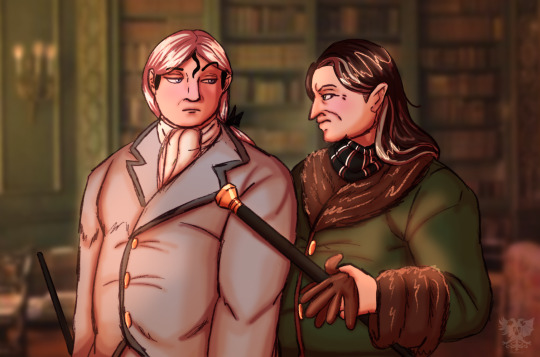
„Behave yourself in this house“
Let‘s just say Spencer and Henry have an interesting relationship with one another. The two are at a Gresley family gathering or something hosted by Gordon on Sodor. And Spencer doesn’t like to be told how to behave.
#ttte#thomas and friends#ttte humanized#ttte human au#ttte henry#henry the green engine#ttte spencer#spencer the silver engine#ttte gijinka#gresley family#lner a4#frankly these two hate each other’s guts#ttte human henry#ttte humanisation#thomas and friends humanized#Gresley family beef#Funnily enough you can tell they are cousins
28 notes
·
View notes
Note
We know about the current A4s still around, but what about the ones that were scrapped? Were they friends with any of the A3s? Did any of them go to Sodor?
There are a few of note in the Young Iron AU:
Falcon - 4484: Was Bittern's best friend and closest brother back in the day. He was a clever and quiet thing, a big contrast to Bittern's loud personality. Went to Sodor once for a Gala and befriended James.
Quicksilver - 2510: She was Spencer's (at the time Sliver Link's) good friend and they had a playful sibling rivalry. They had a strong little friend group with several A3s; Night Hawk, Colorado and Sir Hugo.
Capercaillie - 4901: Named after a very angry and aggressive Scottish bird because of his attitude. Constantly fought with the A3s and saw them as weak relics of the past. Not pleasant to be around and even less pleasant towards Peppercorn's engines.
Gadwall - 4469: A good friend to Great Northern. Sadly was scrapped in 1942 after it was damaged by a bomb during World War II. This event marked Great Northern's descent into becoming ridiculed by the other A3s after he became less of a patriarchal figure in the A3 family unit. His role would be taken by Banbury and then Flying Scotsman.

Silver Fox - 2512: An A4 that was closest to Flying Scotsman and occasionally pulled his express. She was an intelligent and clever engine who Bittern looked up to and admired. Kind-hearted and Soft she often confided in Scotsman and admired him and the other A3's.
#my asks#ask answered#lner a4#ttte young iron au#ttte fanfic#ttte flying scotsman#ttte great northern#ttte spencer#ttte bittern#ttte mallard#ttte a4#ttte au#ttte young iron
30 notes
·
View notes
Note
can you tell us about the mallard steam loco?????
I did a whole post on Mallard back on the anniversary of her run on July 3rd! You can read it here!
She's my absolute favorite steam locomotive and I'd love to be on the footplate but she hasn't operated since the late 1980s. There's some other A4s currently operable, though, so hey, you never know, maybe one day I'll get on the throttle myself!

9 notes
·
View notes